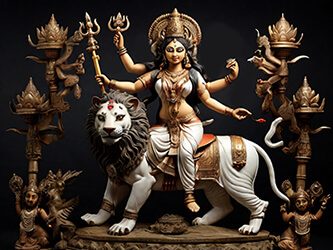Watch nearly 400 videos on the Vocal Medicine Channel!
Durga Mantra to a Hindu Goddess
Many Durga mantras contain a powerful sequence of multiple seed syllables. The lyrics to Durga’s Mantra for Protection are “OM HRIM KRIM DUM Durgayai Svaha.”
The Meaning of OM
The Sanskrit word OM is familiar to most people as the quintessential one-word mantra. OM is the fundamental sound connecting us to higher reality and the highest aspect of our own beings. Although a mantra all unto itself, OM is also the most common word in longer mantras.
The Meaning of HRIM
HRIM (hreem) is a mantra for the heart: the spiritual heart, the emotional heart and the physical heart. This mantra aids in longevity by energizing the heart. Due to the healing and stimulating influence on the heart, HRIM is also said to promote circulation and positively affects the lungs and nervous system. This word in the Durga mantra accelerates the fire in the heart.
Share this page with a friend!
The Seed Syllable KRIM
KRIM is a mantra of divine manifestation, specifically the divine electricity that exists behind all things. There is something about repeating this sound that feels like a mild, positive electrical stimulus. The word KRIM adds a second kind of fire to Durga’s mantra.
Hard Consonant Seed Syllables
In fact, KRIM is the most important of the seed syllables beginning with a hard consonant. The Sanskrit letter “k” or “ka” is an initial thrust of energy or prana. The letter “r” or “ra” adds fire and the “i” (ee) adds focus.
KRIM as the Power of Shakti
KRIM is the Kriya Shakti or power of action that operates on all levels. The inner action is the awakening of the kundalini. KRIM also rules over time, helping us to move from past karma and master time, space and action. KRIM is the final seed syllable in this mantra to Durga before her own seed syllable DUM, described in detail in Durga’s Primary Mantra above. Or read a full article on seed syllables: One Word Mantras: Powerful Bija Seed Syllables.
Related Video Shorts
Watch nearly 400 videos on the Vocal Medicine Channel!
Durga Mantra for Nine Forms of the Goddess
Durga appears in nine different forms, each with unique traits and powers. Together, they are called “Navadurga” or the “nine Durgas.” In the festival called Navaratri, all of her forms are celebrated over nine nights. There are Durga mantras for each of her nine forms.
Durga Mantra to Shailaputri (First Day of Navarati)
During the first night of Navarati, Durga’s avatar Shailaputri is celebrated. This name means “daughter of the mountains.” She is the daughter of the king of the Himalayas. Shailaputri is the highest or purest form of Durga. In this form, Durga is the mother of nature. She is pictured riding a bull while holding a trident in one hand and a lotus blossom in the other.
Durga Mantra for the 1st Day: Om Devi Shailaputryai Namah
Durga Mantra to Brahmacharini (Second Day of Navarati)
The second day of Navaratri is devoted to Durga as Brahmacharini. This name means the “one who practices devout austerity.” She holds a rosary in her right hand and a water utensil in her left hand. The rosary symbolizes special Hindu prayers recited to her. The water is for marital bliss. Durga is believed to endow peace, prosperity, happiness, and grace upon her followers.
Durga Mantra for the 2nd Day: Oṃ Devī Brahmacāriṇyai Namaḥ
Durga Mantra to Chandraghanta (Third Day of Navarati)
The third manifestation of Durga is a representation of peace, tranquility, and prosperity. Her name, Chandraghanta, is derived from “Chandra” (a half moon depicted on her forehead) and the ghanta (a bell). Durga rides a lion in this form. Chandraghanta is celebrated on the third day of Navarati.
Durga Mantra for the 3rd Day: Oṃ Devī Chandraghantaye Namaḥ
Durga Mantra to Kushmanda (Fourth Day of Navarati)
Durga’s fourth form is Kushmanda, meaning “creator of the universe.” Kushmanda is the one who brought light to the dark cosmos. She also has multiple limbs holding weapons, glitter, a rosary, and holy objects. The glitter is symbolic of the light she brought to the world. In this form, Durga rides a lion. Kushmanda is celebrated on the fourth day of Navarati.
Durga Mantra for the 4th Day: Oṃ Devī Kuṣhmāṇḍā Namaḥ

Durga Mantra: Skandamata (Fifth Day)
Skandamata is the mother of Lord Kartikeya, who was chosen by the gods as their commander-in-chief in the war against the asuras or demons. Skandamata has a pure and divine nature. She is seated on a lotus or lion, possessing four arms and three eyes. She holds the infant Skanda (Lord Kartikeya) in one arm. Skandamata is celebrated on the fifth day of Navarati.
Durga Mantra for the 5th Day: Oṃ Devī Skandamātāyai Namaḥ
Durga Mantra to Katyayani (6th Day of Navarati)
Katyayani is the sixth form of Durga celebrated in Navarati. Katyayani has wild hair, 18 arms (each holding a weapon) and rides a lion. Katyayani was born in a fit of divine rage and anger. She emits light that darkness and evil cannot hide from. Though Katyayani looks terrifying, she is believed to bestow a sense of calm and peace upon her followers.
Durga Mantra for the 6th Day: Oṃ Devī Kātyāyanyai Namaḥ
Durga Mantra to Kalaratri (7th Day of Navarati)
Kalaratri is also known as Shubhamkari. Her name means “one who does good” in spite of her fearsome looks. She has a dark complexion, wild hair, four arms, and three eyes. Lightning comes from her necklace and flames shoot from her mouth.
Kalaratri is similar to Kali: she has black skin and is worshipped as a protector of faithful Hindus. She is to be honored and feared. Kalaratri holds a spiked club and a dagger. Two of her other hands beckon to the faithful to be protected and dispel their fears. Kalaratri is celebrated the seventh day of Navaratri.
Durga Mantra for the 7th Day: Oṃ Devī Kālarātryai Namaḥ
Durga Mantra to Mahagauri (8th Day of Navarati)
Mahagauri means “extremely white.” This is the eighth form of Durga. The name Mahagauri refers to Durga’s luminous, radiating beauty. By worshipping her, Hindus believe that all sins – past, present, and future – will be washed away. She wears all white, has four arms, and rides a bull. Mahagauri holds a small tambourine and a trident. Another hand grants blessings. Another is held in a gesture allaying fear.
Durga Mantra for the 8th Day: Om Devi Mahagauryai Namah
Durga Mantra to Siddhidatri (9th Day of Navarati)
Siddhidatri is the final form of Durga. Her name means “giver of supernatural power.” Hindus believe she gives blessings to gods and worshippers alike. Siddhidatri grants wisdom and insight. She also rides a lion, carries a trident, a chakra discus, a conch shell, and a lotus.
Durga Mantra for the 9th Day: Om Devi Siddhidatryai Namah
DURGA MANTRA ARTICLE SUMMARY
The story of Durga is the story of spiritual protection in the form of a Hindu goddess. Durga’s name means “fort” and her role is to defend her devotees. This article includes her protection mantra: “OM HRIM KRIM DUM Durgayai Svaha.”
Click for all content on our Site Map
Author Kathleen Karlsen
Kathleen Karlsen is a musician, artist, writer and speaker. She is the author of two books (Flower Symbols and Vocal Medicine) and over 200 articles. Kathleen, her husband Andrew, and their five children live in Bozeman, Montana. More about Kathleen Karlsen.
RELATED ARTICLES
Share this page with a friend!
![]() Vocal Medicine Music on Spotify!
Vocal Medicine Music on Spotify!





